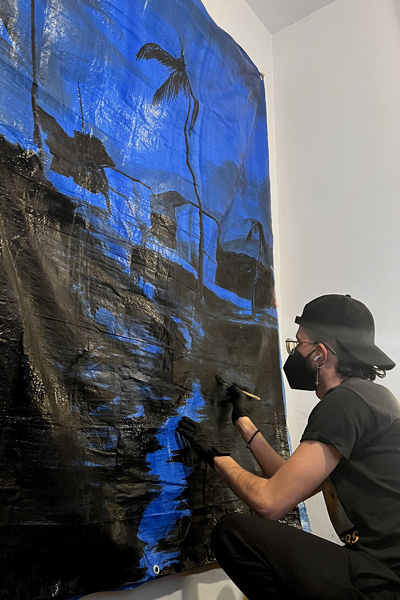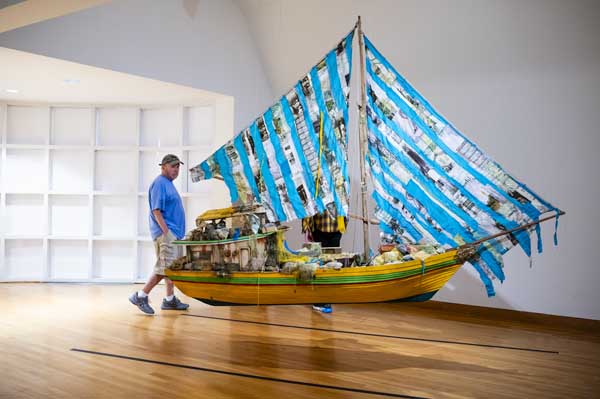Puerto Rican Artist Lionel Cruet Featured in Des Moines Art Center’s Hurricane Season Exhibition
Header image courtesy of Des Moines Art Center, Photo by Brittany Brooke Crow
With a few dashes of yellow paint, artist Lionel Cruet tells us that, against all odds, the lights are still on in a small house in the Puerto Rican countryside. In “Flood Aftermath and Other Hurricane Stories V,” Lionel Cruet depicts the silhouette of a modest home in a mountainous landscape directly on a vibrant blue FEMA tarp. Cruet’s burst of light shows us a determination to continue, even as his loose application of paint in the foreground suggests a landslide. Blue tarps are laden with meaning throughout the global south. Used to provide temporary shelter after natural disasters, blue tarps evoke a home under threat and exposure to the elements. The burst of yellow light conjures the haunting hum of a generator barely holding on through a blackout. After Hurricane Maria devastated many Caribbean islands in 2017, some parts of Puerto Rico remained without power for more than a year. Puerto Ricans stood in line all day to power their generators, even for a few hours, to keep their food and medicine cool or to charge phones to remain in contact with the outside world. Cruet installs his painting unframed, a few inches from the wall so that it billows with any movement in the gallery, highlighting how flimsy the tarp is, how ineffective as a meaningful source of shelter. “Flood Aftermath” is about a home under threat, cycles of environmental violence and the stalwart will to stay even when more devastation is on the horizon.

Lionel Cruet, Photo by Lionel Cruet Studio
Hurricanes have long been a part of life in the Caribbean, but with climate change, these storms are getting far more violent. They gather momentum faster than ever before, leaving little time to prepare. Even as the effects wreak havoc on the region, life across the Caribbean archipelago continues. People adapt. They weather the storm, even as they are weathered by it. The artists featured in “Hurricane Season: Caribbean Art and Climate Change” (on view at the Des Moines Art Center through Sunday, Sept. 22, 2024) demonstrate the crucial role the arts can play in this unfolding crisis by translating data sets and dire predictions into relatable terms, reframing the conversation to how changes in the climate relate to an everyday lived experience, to notions of community, family and home. They translate a global crisis to a human scale.
There are two central challenges to creating art about climate. The first is the climate’s imperceptible scale. Unlike weather, which can be felt and experienced, climate is an average measurement, an abstract assessment based on statistics and data gathered over an extended period. As such, translation is required to make changes to the climate — measurements and compilations of data — relatable to an everyday experience. The second challenge is avoiding the art historical trope of the “sublime.” Often associated with 19th-century landscape paintings, the sublime is an aesthetic category that presents nature as vast and insurmountable. Many artists today use the language of the sublime to impress on the wider public the incredible impact humans can have on the environment. But this visual strategy can be counterproductive. While the sublime can help convey the enormity of the crisis at hand, it often produces feelings of powerlessness in the viewer that can be immobilizing.
“Hurricane Season” assembles artworks by six artists from across the Caribbean and its diaspora who address the crisis from a different perspective that I call “weathering.”i These artists explore the dual, almost paradoxical meanings of the term — one can weather a storm and be weathered by it — showcasing a determination and tenacity to overcome while acknowledging the terror and hardship. They accept the realities of the environmental disaster at hand and engage with it by emphasizing its human toll and, oftentimes, the possibilities of a better future. “Hurricane Season” represents several strategies for threading this needle, including collapsing scale and imagining new futures.
Collapsing Scale
Lionel Cruet’s “Stacks” layers scientific and personal imagery, placing radically different visions of the Caribbean into direct conversation and situating data within an everyday context. In these digital collages, the artist pairs visualizations of the warming of the Atlantic Ocean, the cool blue waters blaring with alarming reds, oranges and yellows, with the brilliant fiery colors of a sunset in his home in Puerto Rico. He further disorients the viewer by mixing satellite images taken from above and pictures of the sky taken from below. Viewers are left in a nebulous in-between place, continually pulled between terrifying global prognostications and grounding visions of home. Cruet thereby shows us the lived experience that is under threat as a direct result of warming oceans.

Photo Credit: Courtesy of Des Moines Art Center, Photo by Brittany Brooke Crow
Imagining New Futures
Rebecca Solnit recently pointed out that the word “emergency” stems from the word “emerge”: “to exit, to leave behind, separate yourself from, so an emergency is when you exit from the familiar and the stable.”ii But the word can also mean “to become apparent,” from the Latin word emergere, which means “to arise.” These parallel meanings of the word emergency speak to a central feature of weathering: the belief that one day the storm will pass, the chaos of the aftermath will settle, and a time of rebuilding and reimagining will begin. Cruet envisions architecture for the Puerto Rico of the future that is inspired by mangroves in his series “Habitats.” Mangroves flourish in tropical coastal areas and are resistant to flooding due to their arched, tangled roots that grow above ground. In his Habitats drawings and sculptures, Cruet learns strategies of adaptation from nature, creating futuristic dwellings that will allow Puerto Ricans to stay on the archipelago even as the sea rises.
During hurricane season, an entire community can be blown away with the passing of a single storm. Homes, schools, photo albums, precious family heirlooms, all carried out to sea. Weathering is about wrestling with these questions: How do we accept a new reality and carry on? How do we continue to find joy and wonder? What do we take with us? How can we adapt? Artists who engage weathering as an approach to the crisis — those who acknowledge grim realities while allowing space for necessary and urgent action — can shake viewers awake from crippling feelings of powerlessness.
[1] This framework of the double meaning of the term weathering is inspired by research by Dr. Arline T. Geronimus, a Professor of Health Behavior and Health Education at the University of Michigan, specifically her book Weathering: The Extraordinary Stress of Everyday Life in an Unjust Society (New York: Little, Brown Spark, 2023), as well as Dr. Hershini Young’s discussion of Geronimus’s work in her essay “Rebelling Ponds and Other Types of Weather” in Deborah Jack: 20 Years (New York: Pen + Brush, 2021), 38-77.
[1] Rebecca Solnit, “Difficult Is Not the Same as Impossible,” in Not Too Late: Changing the Climate Story from Despair to Possibility, edited by Rebecca Solnit and Thelma Young Lutunatabua (Chicago: Haymarket Books, 2023), 4.
Upcoming Related Events
Helpful Links
The Greater Des Moines Partnership calendar of events is a one-stop resource for activities taking place throughout the region. Find networking information for Greater Des Moines (DSM) businesses, including Chamber luncheons, roundtables and ribbon cuttings. You can also find live music happening each week thanks to the “Live Music This Week in DSM” blog series.